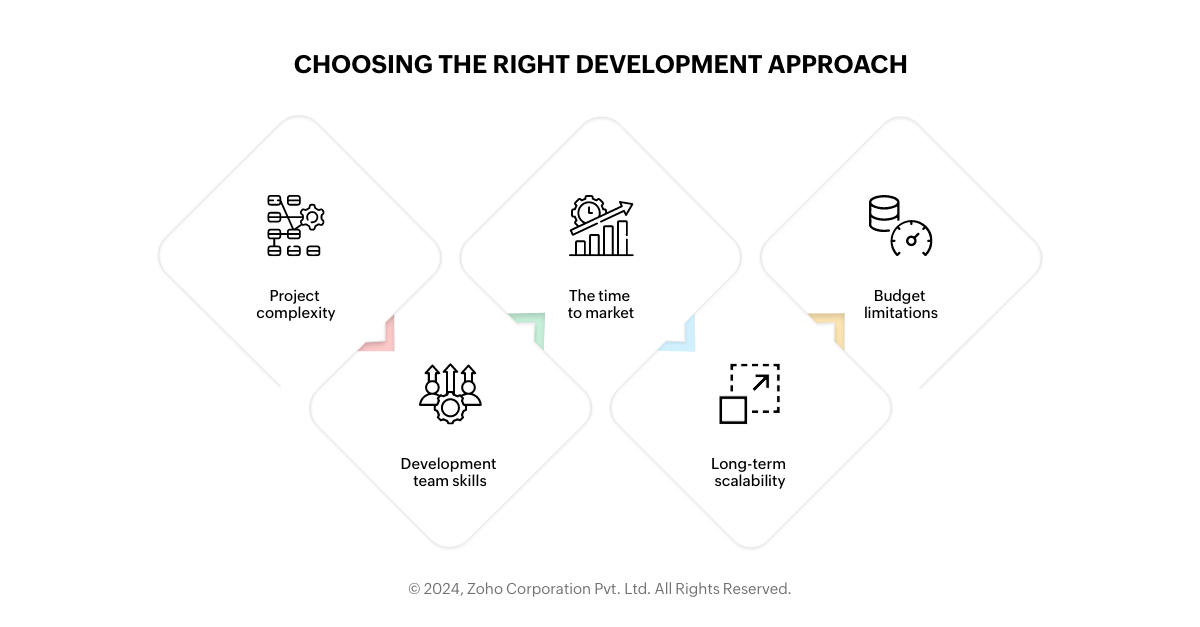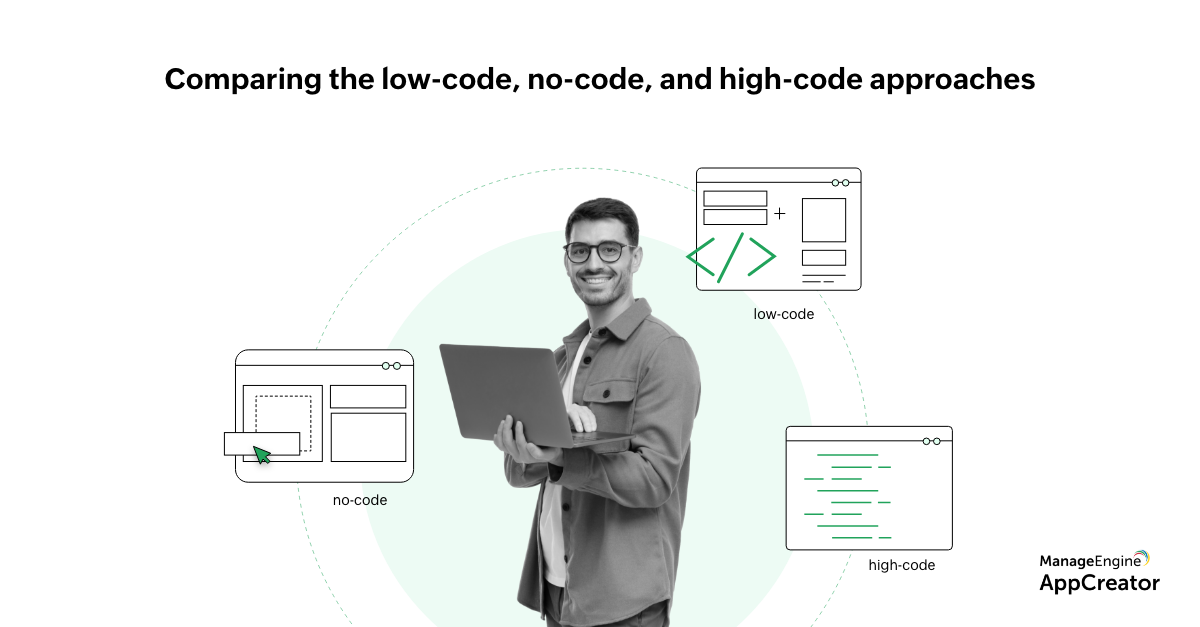Low-code, no-code, and high-code platforms: Similarities, differences and what to choose?
- Last Updated: June 3, 2025
- 391 Views
- 8 Min Read

Businesses are constantly seeking efficient and rapid software development solutions to drive innovation and improve operational efficiency. One crucial aspect of business transformation is software development, which plays a significant role in achieving these goals. However, choosing the right development environment and methodology is essential to ensuring seamless operations and successful software delivery.
In recent years, low-code development and no-code tool approaches have gained popularity among business development teams of all sizes. These approaches enable enterprises to build software products without relying on traditional coding languages, making development faster and more accessible to a wider range of users. However, high-code development still holds advantages in terms of flexibility and scalability. In this comprehensive guide, we will compare the low-code, no-code, and high-code development methodologies. By understanding the benefits and drawbacks of each approach, you can make an informed decision about the software development methodology that best suits your business processes, goals, and resources.
Understanding low-code development
What is low-code development?
Low-code development is a software development model that requires minimal coding to create applications. Instead of complex programming languages, a low-code visual development platform lets users use visual interfaces and drag-and-drop components to design and develop applications quickly. This approach allows users with minimal coding skills to create applications through simplified logic and intuitive design tools.
Benefits of low-code platforms
Low-code application platforms offer several benefits that make them an attractive option for citizen developers seeking rapid application development:
Rapid application development: Low-code platforms enable businesses to quickly deploy applications to meet their needs. The visual interfaces and prebuilt components allow users to create applications faster than they would with traditional coding methods.
Minimal coding skills required: Users with minimal coding skills can design and develop applications with a low-code platform. The drag-and-drop components and visual interfaces that come with low-code tools make the development process more accessible to a wider range of users.
A streamlined development process: A low-code platform streamlines the development approach, saving time and effort. By eliminating the need for extensive coding, developers can focus on creating efficient applications using prebuilt components and automation features.
Cost savings: A low-code platform reduces the need for extensive coding resources, leading to cost savings in development time, labor, and maintenance. This makes it an attractive option for businesses with limited budgets.
Rapid prototyping and testing: Low-code app development platforms enable businesses to prototype quickly and test ideas, allowing for faster product delivery. This iterative approach allows for continuous improvement and innovation, as well as even faster mobile app development, all without coding knowledge.
Drawbacks of low-code platforms
While low-code platforms offer numerous benefits, there are some drawbacks to consider:
Security limitations: A low-code development platform may have limitations in terms of security features and controls compared to hand-coded solutions. This can be a concern for businesses that deal with sensitive data or require stringent security measures.
Difficult migration: It is difficult to transfer low-code applications to other platforms, which could result in potential data loss and additional costs.
A learning curve: Users may need to invest time and effort in learning how to use a low-code development platform and discovering its limitations. This may not be feasible for everyone, especially for businesses with limited resources or tight deadlines.
Exploring no-code development platforms
What is no-code development?
A no-code development platform allows users to build applications without coding skills. These platforms provide drag-and-drop components and a visual interface that simplifies the application development process. No-code development apps and platforms empower nontechnical users to showcase their creative ideas and design applications without relying on traditional coding languages.
Benefits of no-code platforms
No-code development platforms offer several benefits for businesses
Coding-free application development: No-code platforms enable users to construct applications without coding skills. The visual interface and drag-and-drop components make the development process accessible to a wide range of users, including nontechnical individuals.
A faster time to market: No-code platforms reduce the development time as developers are not needed to write extensive code. This allows business users to bring their products to the market faster, giving them a competitive edge in the digital landscape.
Lower development costs: By eliminating the need for developers, a no-code platform can significantly reduce development costs. This makes it an attractive option for businesses with limited budgets or resources.
Increased agility and productivity: No-code platforms democratize the development workflow, allowing nontechnical users to showcase their creative ideas and designs. This enhances productivity and empowers individuals to contribute to the development process, leading to increased agility and innovation.
Drawbacks of no-code platforms
While no-code platforms offer simplicity and accessibility, they also have some drawbacks:
Limited customization options: No-code platforms provide limited customization options, making them less suitable for complex, highly specialized use cases. Businesses with unique requirements may find it challenging to achieve their desired level of customization with no-code platforms.
A lack of advanced capabilities: No-code platforms may lack advanced capabilities compared to high-code or low-code platforms. This limits businesses that require complex features or integrations with external systems.
A learning curve: Users may need to invest time and effort into learning how to use a specific no-code platform and discovering its limitations. This can be a barrier for businesses with tight deadlines or limited resources.
Limited control over the code and infrastructure: No-code platforms abstract away the underlying code and infrastructure, limiting the control users have over these aspects. This can be a concern for business users who require full control over their applications' performance, security, and integration capabilities.
Learn more about low-code vs no-code
Embracing high-code development
What is high-code development?
High-code development is the conventional approach to software development that relies on programming tools to build software. High-code platforms provide extensive customization options and give developers full control over their applications' design, capabilities, and integrations with other systems.
Benefits of high-code platforms
High-code platforms offer several benefits for professional developers and businesses:
Flexibility and customization: High-code development allows developers to use any programming language and gives them full control over customizing the application. This makes a high-code platform suitable for projects that require intricate capabilities and unique features.
Seamless integrations: A high-code platform enables seamless integrations with other systems, APIs, and databases. This makes it the best option for designing complex applications that require integrations with external services or data sources.
Code reusability: High-code development reduces code redundancy and allows developers to reuse code across different projects. This saves time and effort in the long run and promotes consistency and efficiency in development.
Comprehensive testing and debugging: High-code platforms allow for comprehensive testing and debugging, making it easier to identify and fix issues effectively. This ensures the quality and reliability of the application.
Drawbacks of high-code platforms
While high-code platforms offer extensive customization and control, they also have some drawbacks:
A steeper learning curve: High-code development requires advanced programming knowledge and skills. This results in a steeper learning curve compared to no-code or low-code approaches and makes it challenging for beginners or nontechnical users.
Longer development times: High-code development may require more development time as developers need to build complex capabilities from scratch. This is an important consideration for businesses with tight deadlines or limited resources.
Higher development costs: High-code development requires experienced developers with advanced coding skills, which results in higher development costs. This may pose a challenge for businesses with limited budgets or resources.
Comparing the low-code, no-code, and high-code approaches
Now that we have explored the benefits and drawbacks of the low-code, no-code, and high-code development approaches, let's compare these models to help you make an informed decision about the most suitable approach for your project.
Similarities between low-code, no-code, and high-code development
Rapid application development: All three approaches aim to expedite the application development process compared to conventional software development.
Visual development capabilities: Both low-code platforms and no-code platforms use visual interfaces and drag-and-drop components to simplify the application development process.
Customization: While high-code platforms provide the highest level of customization, both low-code and no-code platforms offer varying degrees of customization options.
Collaboration: All three approaches encourage collaboration between developers and other stakeholders, enabling faster development and innovation.
Differences between low-code, no-code, and high-code development
Coding requirements: Low-code and no-code platforms require minimal to no coding skills, while high-code platforms rely on extensive programming knowledge and skills.
The learning curve: High-code development has a steeper learning curve compared to low-code and no-code development, which are designed to be more accessible for nontechnical users.
Development times and costs: Low-code and no-code development offer faster development times and lower costs compared to high-code development, which requires more time and resources.
Flexibility and scalability: High-code development provides the highest level of flexibility and scalability, making it suitable for complex and custom applications.
Control over the code and infrastructure: High-code platforms offer full control over the custom code and infrastructure, while low-code and no-code platforms abstract away these aspects.
Choosing the right development approach

Now that we have examined the similarities and differences of the low-code, no-code, and high-code approaches, it's time to determine which approach is the most suitable for your project. Here are some factors to consider when making your decision:
Project complexity: If your project requires intricate capabilities, extensive customizations, and integrations with external systems, high-code development may be the best choice. High-code development provides the flexibility and control needed to create apps.
The time to market: If speed is a crucial factor, and your project has relatively straightforward requirements, low-code or no-code platforms may be more suitable. These platforms enable rapid application development, prototyping, and testing.
Budget limitations: If you have budget constraints and limited resources, low-code or no-code platforms may be more cost-effective. These platforms reduce the need for extensive coding resources and can save you development time and labor costs.
Development team skills: Consider the skills and expertise of your development team. If you have experienced developers with advanced coding skills, high-code development will be a good fit. However, if your team has limited coding skills or comprises nontechnical users, low-code or no-code platforms will be more accessible.
Long-term scalability: Evaluate the long-term scalability and flexibility of your project. If you anticipate needing extensive customizations, integrations with other systems, and the ability to switch platforms in the future, high-code development offers the most flexibility and control.
It's important to note that there is no one-size-fits-all approach. Every project is unique, and your choice of development approach should align with your specific requirements, goals, and resources. The ultimate winner depends on a thorough understanding of your specific needs and goals.
No-code platforms and low-code platforms expedite the development process of mobile apps and empower nontechnical users to create applications quickly and efficiently. These platforms are ideal for projects with straightforward requirements and limited coding resources. On the other hand, high-code platforms provide the highest level of customization, flexibility, and control, making them suitable for complex and custom applications.
Ultimately, the right development approach for your project depends on a thorough understanding of your specific business needs and goals. If you want to try out low code app development, ManageEngine AppCreator is a feature rich choice!
By considering the factors mentioned in this guide, you can make an informed decision and choose the development approach that best suits your business requirements, facilitating successful software development and innovation in the ever-evolving technological landscape.




